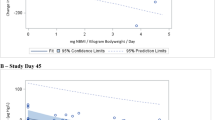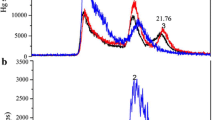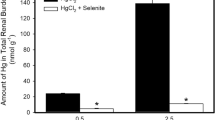Abstract
Among 15 chelating agents tested, sodium-2,3-dimercaptopropane-1-sulfonate (DMPS), 2,3-dimercaptopropanol (BAL), sodium-mercaptoethyliminodiacetate (MEIDA), and D-penicillamine (PA) exerted an influence on the excretion of Hg and its distribution in the organs. The excretion pattern, however, is different for these compounds, and, from the practical point of view, a favourable effect is exhibited only by DMPS which enhances the urinary excretion rate and lowers the Hg-concentration in all organs.
Zusammenfassung
Unter 15 untersuchten Chelatbildnern wurden die Ausscheidung und Organ-verteilung von Hg nur durch Natrium-2,3-Dimercaptopropan-1-sulfonat (DMPS), 2,3-Dimercaptopropanol (BAL), Natrium-Mercaptoäthyliminodiacetat (MEIDA) und D-Penicillamin (PA) beeinflußt. Das Ausscheidungsmuster ist jedoch bei diesen Substanzen unterschiedlich, und einen praktisch günstigen Effekt zeigt nur DMPS, das die renale Ausscheidungsrate erhöht und die Hg-Konzentration in allen Organen senkt.
Similar content being viewed by others
References
Adam, K. R.: The effects of dithiols on the distribution of mercury in rabbits. Brit. J. Pharmacol. 6, 483–491 (1951)
Aposhian, H. V., Aposhian, M. M.: N-Acetyl-D,L-penicillamine, a new oral protective agent against the lethal effects of mercuric chloride. J. Pharmacol. exp. Ther. 126, 131–135 (1959)
Berlin, M., Lewander, I.: Increased brain uptake of mercury caused by 2,3-dimercaptopropanol (BAL) in mice given mercuric chloride. Acta Pharmacol. Toxicol. 22, 1–7 (1965)
Catsch, A., Harmuth-Hoene, A.-E.: New developments in metal antidotal properties of chelating agents. Biochem. Pharmacol. 24, 1557–1562 (1975)
Cherian, M. G., Vostal, J. J.: BAL-induced biliary excretion of mercuric and methyl mercuric ions in the rat. Fed. Proc. 32, 261 (1973)
Chisolm, J. J.: Poisoning due to heavy metals. Pediat. Clin. 17, 591–615 (1970)
Cikrt, M.: Enterohepatic circulation of 64Cu, 52Mn and 203Hg in rats. Arch. Toxikol. 31, 51–59 (1973)
Eybl, V., Sýkora, J., Koutenská, M., Koutenský, J., Mertl, F.: Effect of spironolactone, thiomestrone and dimercaprol on the toxicity, retention and distribution of mercury in the mouse. ArzneimittelForsch. 23, 867–870 (1973)
Eybl, V., Sýkora, J., Mertl, F.: Über den Einfluß der Chelatbildner auf die Ausscheidung und das Verhalten des Quecksilbers bei akuter Quecksilbervergiftung. Naunyn-Schmiedebergs Arch. exp. Path. Pharmak. 252, 79–84 (1965)
Fitzhugh, O. G., Woodard, G., Braun, H. A., Lusky, L. M., Calvery, H. O.: The toxicities of compounds related to 2,3-dimercaptopropanol (BAL) with a note on their relative therapeutic efficiency. J. Pharmacol. exp. Ther. 87 (Suppl.), 23–27 (1946)
Fitzsimmons, J. R., Kozelka, F. L.: Effects of BAL on tissue distribution and excretion of mercury in acute mercury poisoning. J. Pharmacol. exp. Ther. 98, 8 (1950)
Friberg, L., Vostal, J. J.: Mercury in the environment. Cleveland: CRC Press 1972
Guarino, A., Biondi, S.: L'azione del CaEDTA e del BAL nell'intossicazione subacuta sperimentale da mercurio. Folia med. (Napoli) 40, 111–126 (1957)
Hofmann, U., Segewitz, G.: Influence of chelation therapy on acute lead intoxication in rats. Arch. Toxicol. 34, 213–225 (1975)
IAEA, Technical reports series No. 137: Mercury contamination in man and his environment. Vienna: IAEA 1972
Izatt, R. M., Eatough, D. J., Christensen, J. J.: Thermodynamics of cation-macrocyclic compound interaction. Structure and Bonding 16, 161–189 (1973)
Lehn, J. M.: Design of organic complexing agents. Strategies toward properties. Structure and Bonding 16, 1–69 (1973)
Levine, W. G.: Heavy-metals antagonists. In: The pharmacological basis of therapeutics (eds. L. S. Goodman, A. Gilman), pp. 944–957. New York: Macmillan 1970
Longcope, W. T., Luetscher, J. A.: Clinical uses of 2,3-dimercaptopropanol (BAL). XI: The treatment of acute mercury poisoning by BAL. J. clin. Invest. 25, 557–567 (1946)
MacGregor, J. T., Clarkson, T. W.: Distribution, tissue binding and toxicity of mercurials. In: Proteinmetal interactions (ed. M. Friedman), pp. 463–503. New York: Plenum Press 1974
Magos, L., Stoytchev, T.: Combined effect of sodium maleate and some thiol compounds on mercury excretion and redistribution in rats. Brit. J. Pharmacol. 35, 121–126 (1969)
Nigrović, V.: Der Einfluß von Chelatbildnern auf das Verhalten von Quecksilber im Organismus. Arzneimittel-Forsch. 13, 787–792 (1963)
Nigrović, V., Mohr, T.: Ein neuartiger Stoffwechselkäfig für Arbeiten mit Radionukliden. Strahlentherapie 130, 314–316 (1966)
Norseth, T.: The effect of chelating agents on biliary excretion of methyl mercuric salts in the rat. Acta Pharmacol. Toxicol. 32, 1–10 (1973)
Norseth, T., Clarkson, T. W.: Intestinal transport of 203Hg-labeled methyl-mercury chloride in the mouse. Arch, environm. Hlth 22, 568–577 (1971)
Östlund, K.: Studies on the metabolism of methyl mercury and dimethyl mercury in mice. Acta Pharmacol. Toxicol. 27, Suppl. 1 (1969)
Pagnotto, L. D., Brugsch, H. G., Elkins, H. B.: Treatment of chronic mercurialism with N-acetyl-D,Lpenicillamine. Amer. industr. Hyg. Ass. J. 21, 419–422 (1960)
Planas-Bohne, F.: Pharmakokinetische Untersuchungen an 14C-markiertem Penicillamin. ArzneimittelForsch. 22, 1426–1433 (1972)
Quenouille, M. H.: Introductory statistics. London: Pergamon Press 1950
Report of an International Committee: Maximum allowable concentrations of mercury compounds. Arch. environm. Hlth 19, 891–905 (1969)
Silva, A. J., Fleshman, D. G., Shore, B.: The effect of penicillamine on the body burdens of several heavy metals. Hlth Phys. 24, 535–539 (1973)
Swensson, Ä., Ulfvarson, U.: Experiments with different antidotes in acute poisoning by different mercury compounds. Arch. Gewerbepath. Gewerbehyg. 24, 12–50 (1967)
Woodcock, S. M.: A case illustrating the effect of calcium disodium versenate (CaNa2EDTA) on chronic mercury poisoning. Brit. J. industr. Med. 15, 207–208 (1958)
Author information
Authors and Affiliations
Rights and permissions
About this article
Cite this article
Gabard, B. The excretion and distribution of inorganic mercury in the rat as influenced by several chelating agents. Arch Toxicol 35, 15–24 (1976). https://doi.org/10.1007/BF00333982
Received:
Issue Date:
DOI: https://doi.org/10.1007/BF00333982




